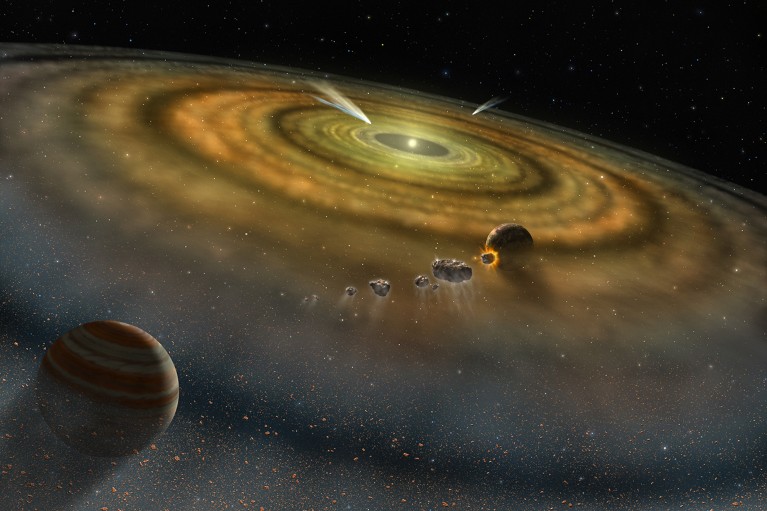Original Interview at:
https://www.nature.com/articles/d41586-023-02922-w
How worlds are born: JWST reveals exotic chemistry of planetary nurseries
The telescope is delivering a cascade of insights about the ‘protoplanetary’ disks where planets take shape.

The James Webb Space Telescope (JWST) is aweing scientists and the public alike with its spectacular images of distant galaxies and its discoveries of dozens of new black holes. Yet JWST is also rewriting scientists’ understanding of objects on a slightly smaller, more relatable scale: how planets form from swirls of gas and dust around young stars. Such ‘protoplanetary’ disks are what the environs of the Sun would have been like 4.6 billion years ago, with planets coalescing from the whirling material around an infant star.
JWST is revealing how water is delivered to rocky planets taking shape in such disks. It’s providing clues to the exotic chemistry in these planetary nurseries. And it has even found fresh evidence for a cosmic hit-and-run in one of the most famous debris disks, encircling the star Beta Pictoris.
Other telescopes have probed many of these disks before. Astronomers have taken impressive pictures of dark gaps etched like grooves in a bright vinyl record, marking where planets are being born and clearing out gas and dust from the disk. But JWST’s unprecedented vision allows astronomers to probe these realms in original ways. “It’s really as if you’re picking out new glasses — you put them on and suddenly, wow, you see much more,” says Andrea Banzatti, an astronomer at Texas State University in San Marcos.
A gift from icy pebbles
Banzatti and his colleagues turned their new JWST glasses to gaze on the protoplanetary disks of four stars. The scientists could see that two of the disks contained large amounts of cool water, just close enough to the star for the water to be liquid rather than frozen1. That observation supports a theory put forward decades ago, that icy pebbles can drift inwards from the outer part of the disk until they get warm enough to release their water into the inner disk.Life in the cosmos: JWST hints at lower number of habitable planets
This reservoir of water can serve as a raw ingredient for planets forming close to the star, Banzatti reported on 14 September at a JWST conference in Baltimore, Maryland. “For the first time, we have measurements of how much water is being delivered to that region,” he says. That could allow astronomers to get a much better sense about what types of planet are forming in various disks.
Meanwhile, other JWST observations show that the protoplanetary disk surrounding a small star called J160532 has a surprisingly large amount of carbon. A planet taking shape in a disk awash in carbon compounds could draw on a wide variety of interesting chemistry as it forms2. Small stars such as this one frequently host small rocky planets; if such planets can sweep up diverse ingredients as they form, the results could be planets that are mind-bogglingly different from our Solar System’s rocky planets, such as Venus, Earth and Mars.
Intriguing chemistry
In Nature Astronomy in May, astronomers reported3 finding benzene in the disk around J160532 — the first observation of the molecule in a protoplanetary disk. Benzene is a carbon-containing ‘organic’ molecule, but its detection probably does not signal the presence of the ingredients required for life. It might mean that radiation flooding from the star is destroying dust grains rich in carbon, releasing benzene into the disk. The disk also contains lots of other carbon-containing compounds, such as acetylene — and indeed has more carbon than oxygen overall.JWST reveals first evidence of an exoplanet’s surprising chemistry
“It’s really a chemistry we’ve never seen before in disks,” says Sierra Grant, an astronomer at the Max Planck Institute for Extraterrestrial Physics in Garching, Germany, who was involved in the work and spoke about it at the conference last week. “We need to do a lot more work in order to understand it, but it’s really intriguing.”
Even disks that have probably already formed all their planets are giving up their secrets to JWST. At the conference, astronomers showed off new images of the disk around Beta Pictoris, a star that lies 19 parsecs from Earth. In 1984, it became the first star known to have a debris disk encircling it4.
These images, yet to be published, have revealed a filament of dust that astronomers are calling the cat’s tail stretching out of the debris disk at a quizzical upright angle. The feature is obvious in the images, but no one had spotted it before because it was not visible except to JWST’s infrared vision, said Marshall Perrin, an astronomer at the Space Telescope Science Institute in Baltimore, at the conference.
Debris trail, cat’s tail
The cat’s tail of Beta Pictoris is probably a stream of dust and other debris that was kicked out of the star’s disk when large rocky chunks smashed into each other. “We’re seeing the aftermath of a massive collision in the disk,” Perrin said. Earlier JWST observations of a disk around the bright star Fomalhaut had also shown clouds and belts of dust expanding outwards, suggesting that lots more could be going on in the system than anyone had suspected5.
“It highlights the power of JWST,” Grant says, “that things we have been studying for years are still surprising us.”
Nature 621, 670 (2023)
doi: https://doi.org/10.1038/d41586-023-02922-w
